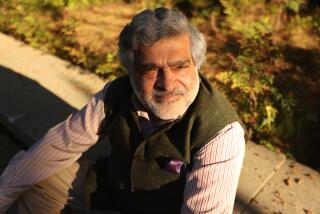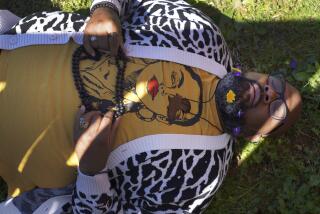Guru’s Followers Mark Legacy of a Star’s Teachings
Indian swami Paramahansa Yogananda strode onto the sunny canvas of Los Angeles in 1925 with tales of magic in a far-off place and a meditation technique he said could liberate the soul.
The charismatic founder of the religious organization headquartered in Mount Washington went on to introduce America to yoga and, with his “Autobiography of a Yogi,” become the 20th century’s first superstar guru.
More than 4,500 people from around the world will gather at the Westin Bonaventure Hotel in downtown Los Angeles today for the Self-Realization Fellowship’s annual convocation, featuring a full week of group meditations and evening classes with titles that include “Balancing Our Spiritual and Material Goals.”
“The bliss you feel in meditation is proof of God’s existence,” Yogananda liked to say.
It was a potent message that attracted fans, as varied as housewives and President Coolidge, who once met with him in the White House. It also spawned a global religious empire of publications, recordings and valuable real estate that has figured in recent bare-knuckles court battles.
This year, the fellowship is honoring the 60th anniversary of “Autobiography” with a series of projects designed to promote the legacy of the man thousands of disciples still refer to as “master.”
Today, there are 639 fellowship temples and meditation centers in 62 countries. The organization recently translated the yogi’s book into its 26th language, Finnish.
“We hope to next translate the ‘Autobiography’ next into Slovenian and Russian,” said Brother Chidananda, a senior manager of the fellowship, “although I hear there are already bootleg versions in those places.”
In addition to establishing a worldwide organization, the California guru developed lush meditation centers on prime real estate in Pacific Palisades, Hollywood, Encinitas and San Diego.
“Yogananda was unique in his time; he seemed to be genuinely sincere,” said J. Gordon Melton, director of the Institute for the Study of American Religion in Santa Barbara. “He also had a corner on the market. It wasn’t until the Beatles hooked up with the Maharishi Yogi in the mid-1960s that Yogananda had any real competition.”
The dark-skinned yogi with shoulder-length hair and flowing robes held court in almost mystic salons at his landscaped retreats. Among his close friends were symphony conductor Leopold Stokowski, who had an active interest in mysticism; famed horticulturist Luther Burbank, who encouraged plants to grow by speaking to them in soothing tones; and Goodwin Knight, who was a California governor and lieutenant governor in the 1950s and an avid astrologer.
Residents of the Mount Washington complex still talk about the time in the late 1960s when Elvis Presley showed up at their door.
“Elvis looked at one of our monks and said, ‘Man, you made the right choice,’ ” recalled Brother Paramananda, who left a promising acting career to devote his life to the fellowship. “Elvis said, ‘People don’t know my life or that I sometimes cry myself to sleep because I don’t know God.’ ”
Fellowship leaders encouraged him to continue singing.
Yogananda’s teaching blended Christianity and the 2nd century Yoga Sutras of Patanjali, a yoga school of philosophy stressing nonviolence, self-discipline, physical exercises, breath control and meditation.
In a recent visit to the small study on a bluff overlooking the Pacific Ocean in Encinitas where Yogananda penned “Autobiography,” a monk named Brother Jayananda said, “You can feel his vibrations in here.”
The room -- off-limits without an appointment -- has been preserved as a shrine since the yogi’s death in 1952.
The desk is topped by a framed photograph of Yogananda at work on the book, pen in hand. A big brass Aladdin’s lamp sits on a leather seat a few feet to the right. Large white spiral-shaped seashells are strewed across the floor in front of the fireplace.
At Mount Washington, Yogananda’s bedroom has been turned into a shrine, where his unfinished last meal of fruit and tea remains wrapped in cellophane. Just around the corner, his collection of stones and minerals sits on a wooden bench in a hallway decorated with portraits of the guru at various ages.
There is hardly a patch of wall anywhere in the Mount Washington or Encinitas compounds without a prominent photograph or portrait of Yogananda, whose visage gazes out in dens and hallways, kitchens and studies, even gazebos.
Critics say fellowship members go overboard in venerating their yogi as a godlike figure. They also point to a spate of recent legal problems as signs that the society Yogananda founded is all too human.
In one case, DNA samples were needed to dismiss an attempt to take over the fellowship by a man who claimed he was Yogananda’s illegitimate son.
In 1990, the fellowship filed a lawsuit against a splinter group known as Ananda to secure exclusive rights to Yogananda’s teachings, name, likeness, voice and use of the term “self-realization.”
That case was resolved in 2002 with a unanimous jury verdict determining that Ananda had infringed on certain copyrights. But it also said the terms “Paramahansa Yogananda” and “self-realization” could not be trademarked.
These days, most people come to know him through his “Autobiography,” which fellowship officials say sells about 50,000 copies a year. It was, as religion scholar W.Y. Evans-Wentz once noted, one of the few books about yogis by a genuine yogi.
The book chronicles Yogananda’s life from his birth in northeast India through his search for a guru and ultimate bliss. Yogananda was born Mukunda Lal Ghosh in 1893 in Gorakhpur, India, into a well-to-do Bengali family.
As a young man, he toured India and made pilgrimages to the Himalayas before at last finding the teacher who fulfilled his spiritual needs, Sri Yukteswar. That teacher gave him the title Paramahansa, which means “highest swan,” a vehicle of the Supreme Spirit.
He arrived in America from India in 1920, when he was invited to serve as a delegate to the International Congress of Religious Liberals convening in Boston.
In 1925, he moved to Los Angeles and established the international headquarters of his spiritual society and a monastic order of monks and nuns who take vows of chastity, obedience and simplicity, living for the furtherance of self-realization.
At Mount Washington, 66 monks and 76 nuns dedicate themselves to the fellowship. Lay members are encouraged to attend Sunday sermons, enroll in a 3 1/2 -year mail-order course and start and end their days in meditation in their homes.
The monks and nuns arise to a ringing phone at 5:30 a.m. and live, work and worship in cell-like apartment rooms -- also festooned with images of the guru -- and surrounded by 12 acres of shady manicured gardens with a spectacular view of downtown Los Angeles.
Much of their day is spent in supporting members worldwide through counseling and letter writing and in disseminating Yogananda’s literature. They also practice “Kriya meditation,” Yogananda’s technique of breathing and concentration of the gaze to control “life energy,” realize one’s true self, or soul, and achieve perfect attunement with God, or samadhi.
It’s not easy, according to fellowship senior spiritual counselor Uma Mata, 71, who was only 9 when Yogananda invited her to join his society.
“I haven’t experienced samadhi,” she said. “It’s what I’m working toward.”



